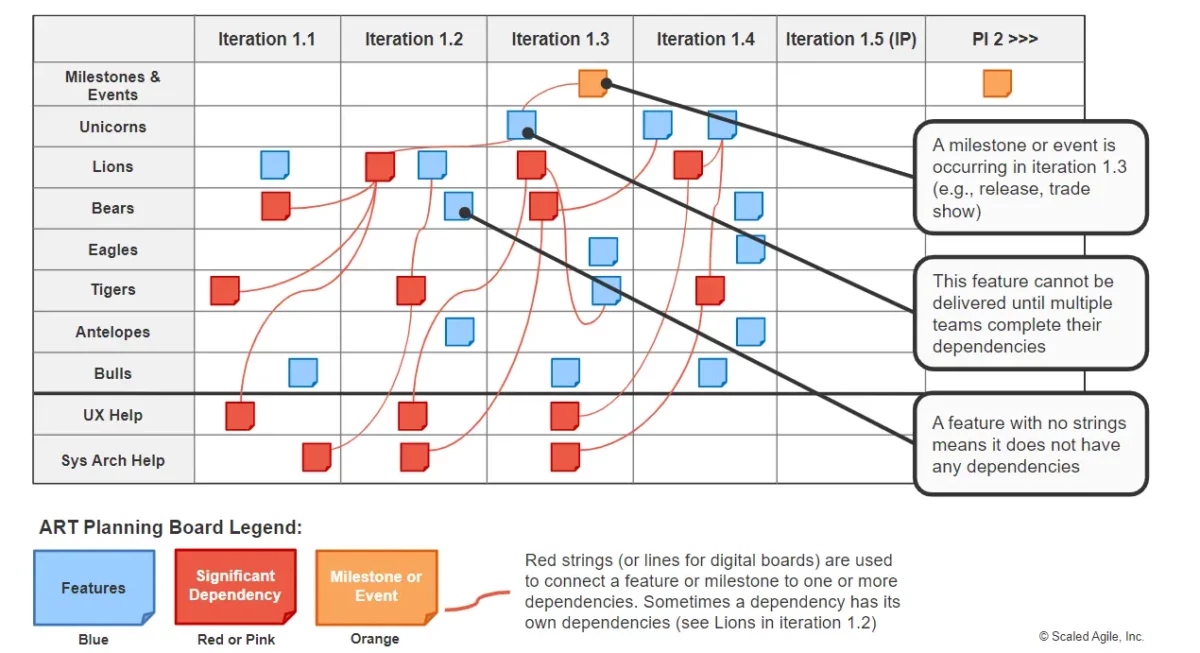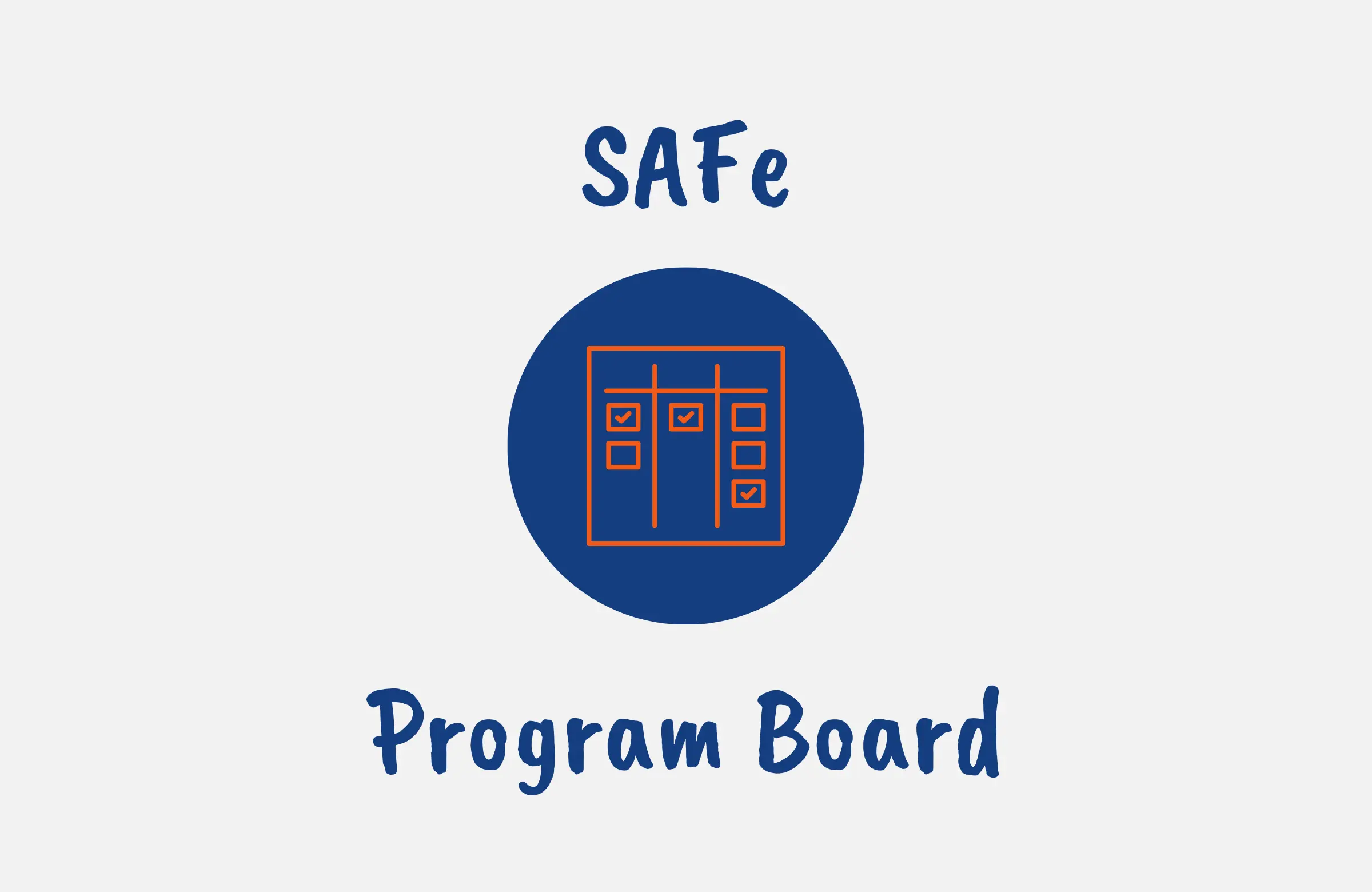The Scaled Agile Framework (SAFe) provides practices and principles for scaling Agile development along different levels up to the enterprise level.
A key event in SAFe is Program Increment (PI) planning, which is used to align teams and stakeholders to a shared mission and vision for the upcoming PI.
One of the most important outputs of PI planning is the creation of a SAFe program board. This visual tool summarizes the plan and helps visualize dependencies for teams in the Agile Release Train (ART).
In this article, we’ll cover what a SAFe program board is, its purpose and components, and how it facilitates coordination and delivery in PI planning.
We’ll also provide tips on how to set up an effective program board using features, iterations, milestones, and dependencies to support PI planning.
What is a Program Board in SAFe?
As iterated earlier, a SAFe program board is a visual planning tool used to coordinate the work of multiple Agile teams during PI planning and throughout a Program Increment (PI).
The SAFe program board is created collaboratively by teams during the 2-day PI planning event and provides a high-level view of the features, milestones, and dependencies that make up the PI plan for teams in an Agile Release Train (ART).
It captures the features that teams commit to delivering in the upcoming PI and maps each feature to the iteration it is scheduled to be completed, and also highlights key milestones such as releases or project deadlines that occur within the timeframe of the PI.
To show interdependencies between teams, the program board uses colored strings or lines to connect dependent features across teams and iterations.
This visual representation helps teams coordinate and sequence their work while avoiding delays. If a feature’s dependency is delayed, the team can adjust its schedule accordingly.
The SAFe program board gives everyone visibility into the big picture and alignment on what needs to be accomplished and facilitates collaboration, dependency management, and synchronized delivery for multiple teams throughout an entire PI.

What is the Purpose of a SAFe Program Board?
The SAFe program board is a vital planning and tracking tool for PI planning success with the overarching goal of aligning teams to deliver value in a coordinated way across a PI.
It serves several important purposes including:
- Visualizing the Plan: The program board provides a high-level visualization of everything the ART aims to accomplish in the PI. It captures all the upcoming features, milestones, and dependencies in one view.
- Facilitating Planning: During PI planning, the program board is used to map out and schedule features across iterations and teams. Moving cards on the board helps teams plan collaboratively and identify dependencies.
- Coordinating Teams: With all team commitments visible on one board, it is easy to spot potential issues like delays, bottlenecks, or conflicts across teams. Teams can proactively coordinate to resolve these.
- Managing Dependencies: Dependency lines between features provide end-to-end visibility into the sequence of work. Teams can track the status of upstream dependencies and quickly adapt if they are at risk of delay.
- Communicating the Plan: The program board gives all stakeholders a snapshot of the PI Objectives and upcoming work. It aligns everyone on priorities and key milestones.
- Monitoring Progress: Teams update the board regularly showing completed work. This allows tracking the progress of features as they move across iterations.
- Facilitating Program Analysis: By capturing the plan and progress in a centralized place, the board provides data to analyze cross-team dependencies, productivity, and delivery trends.

What are the Components of a SAFe Program Board?
The SAFe program board visually brings together all the key elements needed to plan and execute a successful Program Increment (PI).
The board is made up of several core components that enable teams to map out features, dependencies, and timing in a shared view.
1. Teams
Each Agile team in the Agile Release Train (ART) is represented by a horizontal swimlane on the board. This provides dedicated space for the team to map out their specific objectives and plans.
In addition to development teams, shared services teams like User Experience designers, architecture, operations, and security may also have a swimlane. This allows them to visualize incoming work from other teams that will need their support.
The swimlanes make it easy to distinguish which features belong to which team and identify dependencies across teams. For distributed teams, swimlanes provide clear ownership even when planning remotely.
2. Iterations
Columns on the board represent the iterations occurring within the Program Increment timeframe. Typically, teams plan 5-6 iterations which are 2 weeks long.
The last column is used for iteration planning to account for teams pulling in new work at the start of each iteration.
Having every iteration visible enables teams to spread out and schedule features across the PI timeframe based on priority, dependencies, and capacity.
3. Features
Each team breaks down upcoming features from the program backlog and places each one on a feature card within their swimlane. The feature card is positioned in the iteration column where that feature is scheduled to be completed by the team.
Features may span multiple iterations if they are large. Smaller feature breakdowns allow teams to pull in a mix of short and long items. Enabler features that build capability for the system can be represented with a different color card.
4. Milestones
A milestone swimlane at the top of the board is used to identify major milestone dates like releases, operational events, or compliance deadlines. Milestones usually span across teams and iterations.
This quickly shows which features teams need to complete in time for key milestone dates. Teams prioritize features tied to upcoming milestones to ensure delivery on time.
5. Dependencies
Dependent features are connected with lines or strings across teams and iterations. This visualizes the workflow and upstream/downstream relationships.
Teams can clearly sequence their work based on true dependencies and avoid unnecessary blockers. If an upstream dependency moves, the downstream team can quickly adapt its plan based on the program board view.
6. Colors
Color coding cards are an effective way to distinguish different types of work at a glance making the board easier to interpret. For example, blue cards for standard features, orange cards for milestones, and purple cards for enablers.
7. WIP Limits
Applying Work in Progress (WIP) limits is an important Lean practice as teams can limit how many feature cards are pulled into each iteration based on their capacity.
WIP limits encourage completing items before pulling in new ones as too many items often result in excess unfinished work.
8. Help Pool
A dedicated column for the help pool provides a place for teams to visualize work requiring assistance from shared services teams.
For example, if a feature needs design support, the team can place it in the help pool swimlane during planning to get UX bandwidth.
9. Risks
Teams may use callouts on the board to flag high-risk features or milestones needing mitigation. This draws attention to potential roadblocks across the ART.
These components come together on the SAFe program board to create a thorough plan and provide full visibility into the flow of features, dependencies, and milestones across teams in a PI giving everyone a clear picture to align and execute as one unified ART.

How Does a SAFe Program Board Help the PI Planning Process?
The SAFe program board is an invaluable tool for facilitating effective planning during PI planning by bringing interactive visibility that connects teams directly to the planning process and enabling real-time problem-solving and adaptation for a more collaborative, and actionable plan.
Here are some of the key ways it helps:
- Visualizing the Big Picture: Seeing all teams, features, milestones, and dependencies mapped out in one view provides full visibility into the overall PI. Teams understand how their work fits into the bigger picture.
- Scheduling Features: Moving feature cards across iteration columns allows teams to spread out and schedule work. This balances capacity, priority, and timing.
- Identifying Dependencies: Teams discuss and document feature dependencies by connecting cards across the board which prevents silos and misalignment.
- Mapping out Milestones: With milestones mapped to the timeline, teams ensure important dates are accounted for in planning enabling work to be prioritized appropriately.
- Facilitating Collaboration: Coordinating with other teams is simplified when everyone is looking at the same board. Discussing dependencies and co-planning is more efficient.
- Gaining Alignment: All stakeholders align on priorities and upcoming deliverables through the transparent view the board provides.
- Conducting Draft Plan Review: Teams present their draft plan captured on the board to get feedback from stakeholders before finalizing it.
- Making Adjustments in Real-time: As risks or issues emerge in planning, teams can adjust feature placement or dependencies right on the board allowing adaptive planning to be enabled.
- Validating Feasibility: Looking holistically at all team commitments provides an integrated view to validate if the draft plan is realistic and achievable.
- Facilitating Program Analysis: Data can be extracted from the board to analyze cross-team dependencies, value delivery, and productivity across the PI.
- Driving Collaboration Post-planning: The board provides a common reference point for teams to coordinate and track progress during PI execution.

How to Set up Your SAFe Program Board for Successful PI Planning
Setting up an effective SAFe program board requires some forethought and preparation to ensure it facilitates clear planning.
With adequate preparation and real-time adaptation, the SAFe program board can enable transparent, collaborative planning to build a shared plan teams are committed to achieving.
Here are some tips to set it up:
- Define the Board Timescale: Determine the number of iterations and duration of each based on the PI cadence used by the teams. Typically 5-6 columns for 2-week iterations.
- Add Team Swimlanes: Create horizontal swimlanes for each Agile team in the ART. Also include lanes for shared services teams like UX design, architecture, and operations.
- Identify Milestones: Work with stakeholders to determine key upcoming milestones like releases, operational events, or compliance dates for the milestone swimlane.
- Gather Inputs: Connect with Product Management and teams to identify and size the upcoming top features from the backlog to focus the plan around.
- Establish WIP limits: Determine sensible Work-In-Progress limits for how many features each team can pull into an iteration based on their capacity.
- Assign a Facilitator: Have the Release Train Engineer or a dedicated Agile team facilitator manage the board during the planning sessions.
- Go virtual: For distributed teams, set up a digital board using tools like Jira, Trello, or Miro and make it visible to all attendees.
- Train Teams: Ensure teams understand how to use the board to map out features, dependencies, and dates during planning.
- Co-locate when Possible: For large or complex plans, try to bring teams together physically for maximum collaboration.
- Communicate Guiding Policies: Define any program board usage policies like WIP limits, colors for card types, or naming conventions upfront.
- Perform Regular Reviews: Set times for stakeholders to review the draft board during planning to provide inputs and raise concerns.
- Solve Problems Visually: Use the board to debug issues and adjust plans in real-time during planning. Adapt based on learnings.
- Empower Teams: Let teams self-organize to work out dependencies and timing. Provide support rather than mandating changes.
- Capture Risks: Provide a space on the board to visibly call out high-risk features or milestones needing attention.
- Take Photos: Photograph the board after finalizing the plan to memorialize the details and make it accessible post-event.
- Designate Ownership: Ensure there is clear responsibility for maintaining and updating the board after planning as a live information radiator.

When to Use a SAFe Program Board
The primary use of the SAFe program board is during PI planning to visualize and build out the plan for the upcoming PI.
It can also be leveraged continuously across the PI lifecycle and evolves into a valuable radiator for coordinating teams throughout PI execution.
However, it can provide value in these additional scenarios:
- Pre-planning: Building an initial board with known milestones and top features can help in pre-PI planning. This way, teams enter planning with a common starting point.
- Iteration Planning: Reviewing the full PI board provides context for teams as they break down features into iteration plans.
- Iteration Execution: Keeping the board visible and updated helps teams track progress and coordinate dependencies during PI execution.
- Coach Sync Meetings: The Release Train Engineer and Scrum Masters can review the board in regular coaching sync meetings to identify and resolve any emerging issues.
- Post-PI Retrospective: The PI board provides data to look back on milestones met, features delivered, and dependencies managed during retrospective events.
- Pre-PI Planning: Revisiting the previous PI’s board helps teams prepare for the next PI planning event and assess new trends.
- Continuous Improvement: Looking at multiple PI boards over time provides historical data to analyze cross-team dependencies, productivity, and value trends.
Conclusion
The SAFe program board brings together all elements of PI planning into one actionable view enabling teams to map out features, milestones, and dependencies in a shared space to facilitate coordination.
By providing transparency into the big picture, guiding interactive planning, and tracking ongoing progress, the program board is invaluable for aligning large Agile teams to deliver value in a Program Increment powering collaboration and continuous improvement when leveraged across the entire PI lifecycle.
FAQs
What are the Core Values of SAFe?
Scaled Agile Framework (SAFe) is built on four core values:
Alignment: Ensuring that everyone is working towards the same goals
Built-in Quality: Delivering high-quality systems through well-defined standards and practices
Transparency: Offering visibility into project progress for better decision-making
Program Execution: Delivering value through successful program execution, prioritizing working systems over comprehensive documentation
In SAFe Who Manages the Program Board?
In the Scaled Agile Framework (SAFe), the Program Board is primarily managed by the Release Train Engineer (RTE), who is the chief Scrum Master and serves as the coordinator for a team of teams known as the Agile Release Train (ART).
Should Your SAFe Program Board be Physical or Digital?
The choice between a physical or digital SAFe Program Board depends on the team’s needs and circumstances. A physical board can foster collaboration and engagement in co-located teams.
Conversely, a digital board provides flexibility, allowing distributed teams to update and view progress in real-time, and is also easier to manage for large programs. Therefore, both options have their merits based on the team’s situation.
What are the Two Problems That Can be Understood From the Program Board?
The SAFe Program Board can highlight two key issues:
Dependency issues: It visually shows dependencies between different teams, which can reveal potential bottlenecks.
Delivery delays: The board can indicate if features are at risk of not meeting their delivery timeline.





